View this article in another language
- 한국어
- English
- 日本語
- 中文
- العربية
- Español
- Français
- Deutsch
- Pусский
- Tiếng Việt
- Indonesian
*This is the sixth part in our series, “Gat, traditional headgear in Korea.”
Various Types of Gat
Hats are distinguished according to the main material used in their production. The periodical changes in size and materials, combined with the emergence of various symbols and decorations, have given way to a variety of different styles, including the most common heukrip, or black hat. Even though they are manufactured based on the same materials and methods, hats can be classified by their purpose, with the addition of different colors and embellishments.
For instance, the baekrip, a white hat, was used for national mourning when a member of the royal house dies. The jurip, a red hat, was for civil and military offices of the senior third rank or higher, for envoys dispatched overseas and for the royal bodyguards. The jukjeonrip was worn by high-ranking military officials when the king was dressed in military uniform. Hats with jade ornaments are generally referred to as heukrip or jurip. Their tops were decorated with jade and they were worn by active and former civil and military officials as part of their military uniform.

Classification by Material
Hats were classified based on their main material and their added extras. The brim, one of the major components of the hat, was affected by the thickness and the number of saldae, the number and density of dollimjul and by the number of bitdae. According to these variables, the brim can be thinly and gently woven or sparsely and stiffly woven. The difference in the width of the brim does not influence the quality of the hat. A hat with a horsehair crown is called a horsehair hat, for example. Whether the horsehair hat is loose or tight depends on the thickness of the horsehair strands and the number of dollimjul that were used in its making.
Bamboo hats are constructed by attaching fine strands of bamboo together. The way they are attached decides the quality of the hat and produces various brims with different characteristics in fabric and density. Thus, hats vary depending on the main materials and complementary resources. Hats with silk and a bamboo crown and brim included the jimsarip, the eumyangsarip and the eumyangrip. Hats covered by hemp cloth, silk, ramie fabric or cotton were called porip hats.
The Jinsarip
The jinsarip is a bamboo hat of high quality with a refined brim manufactured by repeatedly attaching fine strands of bamboo three or four times. Craftsmen making crowns and brims use heated irons to sear and put together silk threads one by one. As for the crown, strands from the main body are put together on the crown top and, in particular, strands of thread on the top must be placed at a regular interval. To ensure the splendor of the hat, hanji embellishments, called jeonggot and eungak, are added to the inner frame of the crown. A braid of silk threads is attached around the part where the brown and brim join. This hat was generally worn by the king and by noblemen.
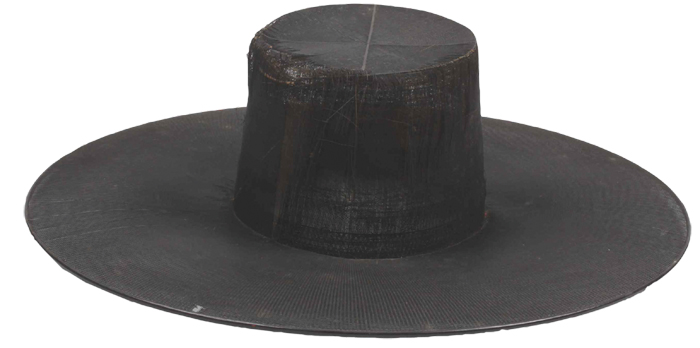
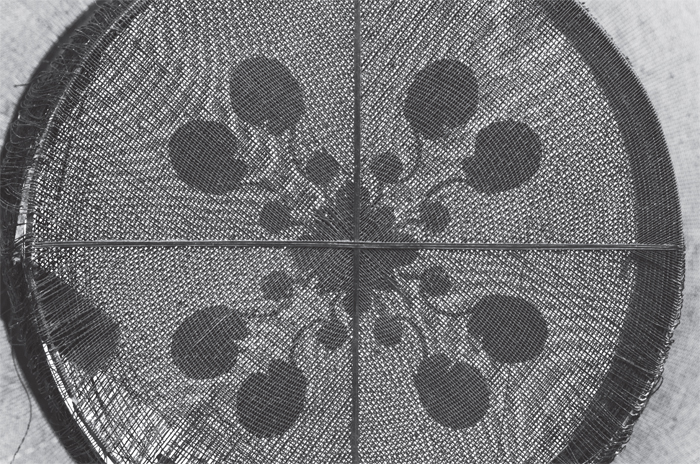
The Juksarip
The juksarip is made similarly to the jimsarip, but instead uses fine strands of bamboo as opposed to silk threads, which are then attached to the crown and brim. The value of this hat is similar to that of the jinsarip.
The Eumyangsarip
The eumyangsarip is a high quality horsehair hat. The quality of an eumyangsarip depends on the additional materials and the width of the silk thread put together over the brim. A hat of the highest quality would be constructed using the golbaegi process, along with the addition of the cheongae and the jeonggot. A hat of the next tier down would be made, again, through the golbaegi process and the addition of only the jeonggot. A third, lower tier would feature hats made solely with the golbaegi process. A low quality eumyangsarip would be constructed by hand with a sparsely woven horsehair brim. The braid thread used for this type of hat is blue.
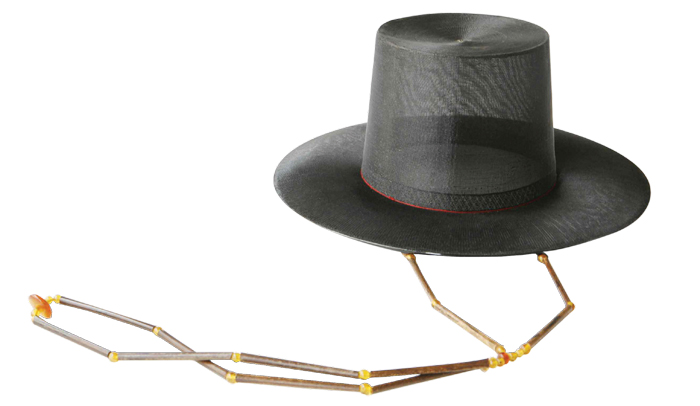
The eumyangrip
The eumyangrip is a hat of lower quality than the eumyangsarip, constructed with a medium-quality brim and a bamboo or horsehair crown. The brim is covered with a silk cloth, while bamboo or silk threads are put together one by one on the exterior of the crown.
The Porip
The porip is made by covering the brim and the crown with a cloth. It is for everyday wear and is easier to construct than fancier hats. The product quality of this type of hat depends on the kind of cloth cover is used, the width of the brim and the height of the crown. Men of the ruling class in the 18th century favored cloth-covered hats with a wide brim measuring around 72cm in diameter. The brim was densely woven and the crown was made by attaching three to four layers of bamboo strands. The porip was likely regarded as among the highest quality types of covered hats.
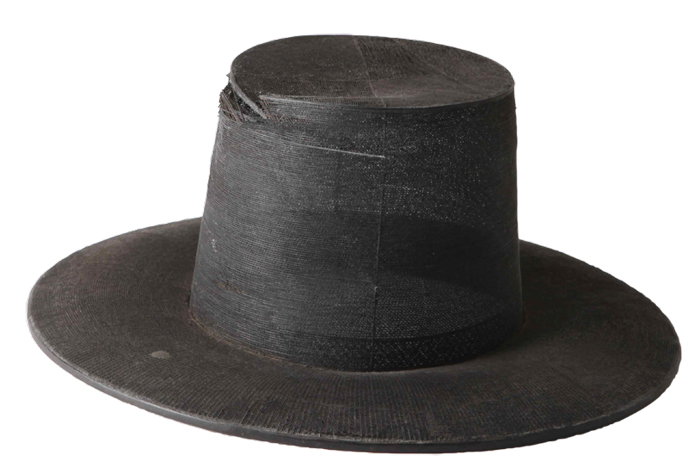
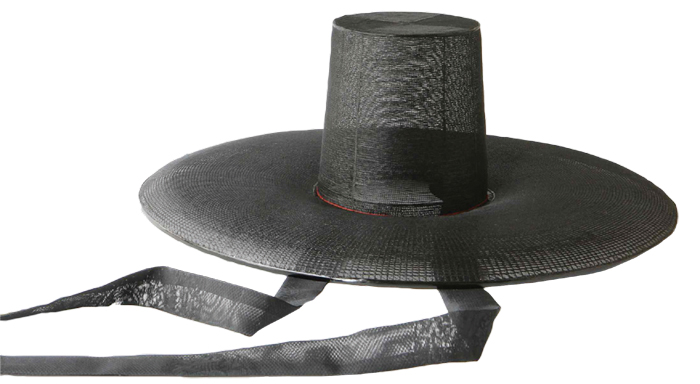
The Baekrip
A baekrip was a white hat worn when one was mourning for a deceased family member or when the nation was mourning for the passing of a king. White hats were worn as early as the early Joseon Dynasty (1392-1910). While the Five Rites of the State (state protocol and etiquette) required the use of a white hat during the mourning period, various historical records show that it was not the only hat worn during times of mourning. People often wore black hats, too, but the controversy over the use of black hats continued until the reign of King Myeongjong (r. 1545-1567), in the middle of the Joseon Dynasty.
White hats were made in the same way as cloth-covered hats. They were covered with cloth but not coated with lacquer or black ink. The crown was made simply by attaching bamboo strands in a diagonal cross patterns and covering the surface with a white cloth. More simply, it was made only with hemp or ramie cloth. This kind of white hat did not feature decorative stiffeners, such as the eungak, as used in the usual cloth-covered hat. These stiffeners were omitted because the hats were made on fairly short notice, upon hearing about the deceased. Instead, a ttamdae, a sort of thinly sliced bamboo strip, or a piece of hanji was attached to the inner frame of the brim. When the mourning period ended, some of the white hats worn by mourners were coated with black ink and used for everyday wear.
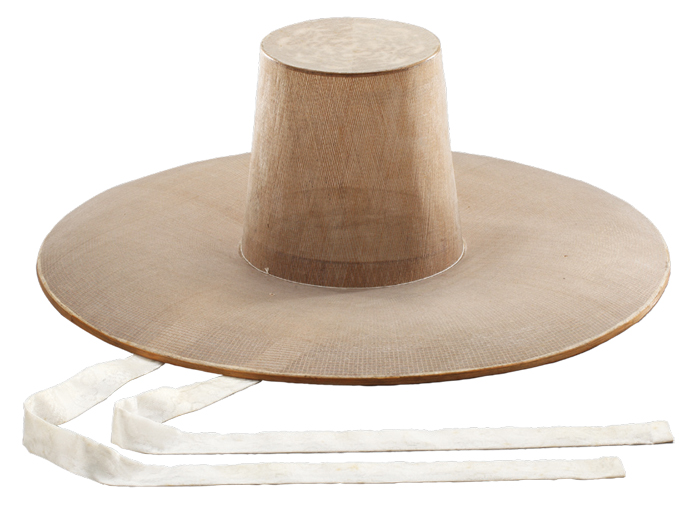
The Jurip
A jurip looks similar to a heukrip, the black hat, but is a dark red color, instead. It was made by covering the surface of a gat with red silk or coating it with red lacquer. Red hats with no joints on the horsehair-woven brim and crown were considered to be of the highest quality. Civil and military officials of the senior third rank or higher wore this hat as part of their ceremonial uniform, for trips abroad as envoys or in attendance with the king during a royal trip. The red hat was usually decorated with three kinds of accessories: two or three white plumes, beaded straps and a crown-top ornament, which showed the official rank of the wearer.
The Jukjeonrip
A jukjeonrip is an official hat worn by officials of high rank. The overall shape of the hat looks similar to an ordinary horsehair hat, with a round or flat crown tip and a lightly curved brim. As with other kinds of horsehair hats, it has a crown and brim woven with bamboo strands. The exterior of the crown and brim is covered with a layer of silk or sheets of cloth, depending on the official rank of the wearer. The decorative accessories, such as any crown-top ornaments, peacock feathers or plumes, also varied depending on the status of the wearer. The red tassel attached to the crown tip looks similar to that of the mojeonrip, a luxurious official hat made of pig hair.
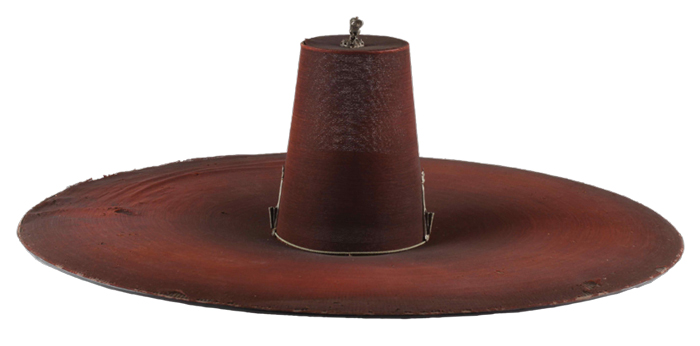
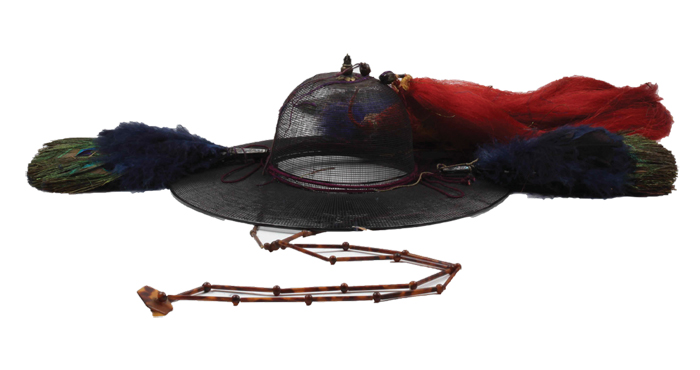
The Okrorip
The name okrorip comes from the heron-shaped jade ornament attached to the top of a black or red horsehair hat. Koreans adopted the Chinese characters ok and ro to refer to “jade” and to the “heron,” respectively. To be precise, the okrorip should be regarded as a style of hat ornament, not specifically as a type of horsehair hat. Nonetheless, such jade ornaments could only be attached to the top of the highest quality horsehair hats, and only with a silk layer, such as a jinsarip or an eunyangsarip. Usually, a bell-shaped crown was decorated with the jade ornament.
According to the Seonghosaseol, the Collected Works of Seongho, the use of okro ornaments was strictly regulated. Only officials higher than the junior second rank could wear jade ornaments. The Daejeonhoetang, the national code published during the late Joseon period, also required active and former civil and military officials to use the jade hat ornaments when they wore their military uniform. This shows that the wearing of the okrorip continued through to the end of the Joseon Dynasty. The difference between the jukjeonrip and the okrorip is whether or not the hat a loop by which one could attach okror elements.
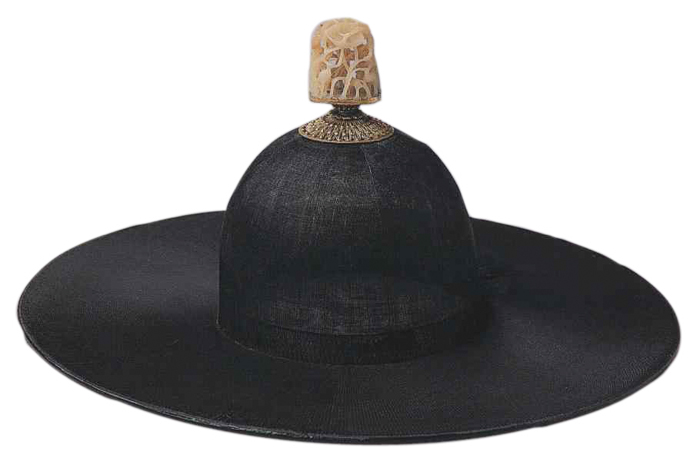
*This series of article has been made possible through the cooperation of the National Research Institute of Cultural Heritage. (Source: Intangible Cultural Heritage of Korea)
Various Types of Gat
Hats are distinguished according to the main material used in their production. The periodical changes in size and materials, combined with the emergence of various symbols and decorations, have given way to a variety of different styles, including the most common heukrip, or black hat. Even though they are manufactured based on the same materials and methods, hats can be classified by their purpose, with the addition of different colors and embellishments.
For instance, the baekrip, a white hat, was used for national mourning when a member of the royal house dies. The jurip, a red hat, was for civil and military offices of the senior third rank or higher, for envoys dispatched overseas and for the royal bodyguards. The jukjeonrip was worn by high-ranking military officials when the king was dressed in military uniform. Hats with jade ornaments are generally referred to as heukrip or jurip. Their tops were decorated with jade and they were worn by active and former civil and military officials as part of their military uniform.

(Left) Weaving the joeuldae; (middle, right) The dollimjul (100, 300)
Classification by Material
Hats were classified based on their main material and their added extras. The brim, one of the major components of the hat, was affected by the thickness and the number of saldae, the number and density of dollimjul and by the number of bitdae. According to these variables, the brim can be thinly and gently woven or sparsely and stiffly woven. The difference in the width of the brim does not influence the quality of the hat. A hat with a horsehair crown is called a horsehair hat, for example. Whether the horsehair hat is loose or tight depends on the thickness of the horsehair strands and the number of dollimjul that were used in its making.
Bamboo hats are constructed by attaching fine strands of bamboo together. The way they are attached decides the quality of the hat and produces various brims with different characteristics in fabric and density. Thus, hats vary depending on the main materials and complementary resources. Hats with silk and a bamboo crown and brim included the jimsarip, the eumyangsarip and the eumyangrip. Hats covered by hemp cloth, silk, ramie fabric or cotton were called porip hats.
The Jinsarip
The jinsarip is a bamboo hat of high quality with a refined brim manufactured by repeatedly attaching fine strands of bamboo three or four times. Craftsmen making crowns and brims use heated irons to sear and put together silk threads one by one. As for the crown, strands from the main body are put together on the crown top and, in particular, strands of thread on the top must be placed at a regular interval. To ensure the splendor of the hat, hanji embellishments, called jeonggot and eungak, are added to the inner frame of the crown. A braid of silk threads is attached around the part where the brown and brim join. This hat was generally worn by the king and by noblemen.

The jinsarip (Seoul National University Museum)

Attaching the strands on the ungi.
The Juksarip
The juksarip is made similarly to the jimsarip, but instead uses fine strands of bamboo as opposed to silk threads, which are then attached to the crown and brim. The value of this hat is similar to that of the jinsarip.
The Eumyangsarip
The eumyangsarip is a high quality horsehair hat. The quality of an eumyangsarip depends on the additional materials and the width of the silk thread put together over the brim. A hat of the highest quality would be constructed using the golbaegi process, along with the addition of the cheongae and the jeonggot. A hat of the next tier down would be made, again, through the golbaegi process and the addition of only the jeonggot. A third, lower tier would feature hats made solely with the golbaegi process. A low quality eumyangsarip would be constructed by hand with a sparsely woven horsehair brim. The braid thread used for this type of hat is blue.

The eumyangsarip (private collection)
The eumyangrip
The eumyangrip is a hat of lower quality than the eumyangsarip, constructed with a medium-quality brim and a bamboo or horsehair crown. The brim is covered with a silk cloth, while bamboo or silk threads are put together one by one on the exterior of the crown.
The Porip
The porip is made by covering the brim and the crown with a cloth. It is for everyday wear and is easier to construct than fancier hats. The product quality of this type of hat depends on the kind of cloth cover is used, the width of the brim and the height of the crown. Men of the ruling class in the 18th century favored cloth-covered hats with a wide brim measuring around 72cm in diameter. The brim was densely woven and the crown was made by attaching three to four layers of bamboo strands. The porip was likely regarded as among the highest quality types of covered hats.

The goeheon of Gotaek House (Sosu Museum)

A porip
The Baekrip
A baekrip was a white hat worn when one was mourning for a deceased family member or when the nation was mourning for the passing of a king. White hats were worn as early as the early Joseon Dynasty (1392-1910). While the Five Rites of the State (state protocol and etiquette) required the use of a white hat during the mourning period, various historical records show that it was not the only hat worn during times of mourning. People often wore black hats, too, but the controversy over the use of black hats continued until the reign of King Myeongjong (r. 1545-1567), in the middle of the Joseon Dynasty.
White hats were made in the same way as cloth-covered hats. They were covered with cloth but not coated with lacquer or black ink. The crown was made simply by attaching bamboo strands in a diagonal cross patterns and covering the surface with a white cloth. More simply, it was made only with hemp or ramie cloth. This kind of white hat did not feature decorative stiffeners, such as the eungak, as used in the usual cloth-covered hat. These stiffeners were omitted because the hats were made on fairly short notice, upon hearing about the deceased. Instead, a ttamdae, a sort of thinly sliced bamboo strip, or a piece of hanji was attached to the inner frame of the brim. When the mourning period ended, some of the white hats worn by mourners were coated with black ink and used for everyday wear.

A baekrip
The Jurip
A jurip looks similar to a heukrip, the black hat, but is a dark red color, instead. It was made by covering the surface of a gat with red silk or coating it with red lacquer. Red hats with no joints on the horsehair-woven brim and crown were considered to be of the highest quality. Civil and military officials of the senior third rank or higher wore this hat as part of their ceremonial uniform, for trips abroad as envoys or in attendance with the king during a royal trip. The red hat was usually decorated with three kinds of accessories: two or three white plumes, beaded straps and a crown-top ornament, which showed the official rank of the wearer.
The Jukjeonrip
A jukjeonrip is an official hat worn by officials of high rank. The overall shape of the hat looks similar to an ordinary horsehair hat, with a round or flat crown tip and a lightly curved brim. As with other kinds of horsehair hats, it has a crown and brim woven with bamboo strands. The exterior of the crown and brim is covered with a layer of silk or sheets of cloth, depending on the official rank of the wearer. The decorative accessories, such as any crown-top ornaments, peacock feathers or plumes, also varied depending on the status of the wearer. The red tassel attached to the crown tip looks similar to that of the mojeonrip, a luxurious official hat made of pig hair.

A jurip (Sungkyunkwan University Museum)

A jukjeonrip (Seoul National University Museum)
The Okrorip
The name okrorip comes from the heron-shaped jade ornament attached to the top of a black or red horsehair hat. Koreans adopted the Chinese characters ok and ro to refer to “jade” and to the “heron,” respectively. To be precise, the okrorip should be regarded as a style of hat ornament, not specifically as a type of horsehair hat. Nonetheless, such jade ornaments could only be attached to the top of the highest quality horsehair hats, and only with a silk layer, such as a jinsarip or an eunyangsarip. Usually, a bell-shaped crown was decorated with the jade ornament.
According to the Seonghosaseol, the Collected Works of Seongho, the use of okro ornaments was strictly regulated. Only officials higher than the junior second rank could wear jade ornaments. The Daejeonhoetang, the national code published during the late Joseon period, also required active and former civil and military officials to use the jade hat ornaments when they wore their military uniform. This shows that the wearing of the okrorip continued through to the end of the Joseon Dynasty. The difference between the jukjeonrip and the okrorip is whether or not the hat a loop by which one could attach okror elements.

An okrorip (Chang Pudeok Memorial Gallery, Ewha Womans University)
*This series of article has been made possible through the cooperation of the National Research Institute of Cultural Heritage. (Source: Intangible Cultural Heritage of Korea)
Most popular
- 2 Egyptian sisters reflect on 10 years as Honorary Reporters
- Actor Bae Doona's first romcom in decade to hit theaters in May
- Korea Welcome Week for foreign tourists set from April 25-May 16
- Korea.net welcomes 2025 K-influencers, Honorary Reporters
- Mini-exhibition brings Korean culture to South London town
![Gat, traditional headgear in Korea [5]](/upload/content/image/1393319340768.jpg)
![Gat, traditional headgear in Korea [4]](/upload/content/image/1392690825210.jpg)
![Gat, traditional headgear in Korea [3]](/upload/content/image/1392095636707.jpg)
![Gat, traditional headgear in Korea [2]](/upload/content/image/1391590339998.jpg)

